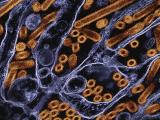Dec 9, 2005 (CIDRAP News) – Two more human cases of H5N1 avian influenza have been confirmed, one in a Chinese woman who has recovered and the other in a 5-year-old Thai boy who died Dec 7, the World Health Organization (WHO) announced today.
The cases increase the human toll of the virus over the past 2 years to 137 cases, including 70 deaths, according to the WHO. Exposure to poultry is the suspected cause in both of the latest cases.
In China, a 31-year-old female farmer from the northeastern province of Liaoning became ill Oct 30 and was treated for severe pneumonia and acute respiratory distress before she recovered, the WHO said, citing the Chinese Ministry of Health. She was discharged from a hospital Nov 29.
The woman initially tested negative for the virus, but a microneutralization test for H5N1 antibodies later was positive, the WHO reported. "Using this test, a positive diagnosis is made when antibody levels in a blood sample taken late in illness are at least four times higher than those found in a sample taken early in illness," the agency said. Antibody tests are reliable but slower than direct tests for viral RNA, the statement said.
Investigators have linked the woman's illness to exposure to sick poultry, the WHO said. Poultry outbreaks of H5N1 flu have occurred in Liaoning province. Contacts of the patient were under medical observation, but all remained healthy and have been released.
China now has had five confirmed human cases of H5N1 infection, of which two were fatal.
In Thailand, health officials confirmed that avian flu caused the death of a 5-year-old boy from the central province of Nakhonnayok, according to the WHO. The boy fell ill on Nov 25, was hospitalized Dec 5, and died 2 days later.
Early results of an investigation suggest the boy might have been infected by contact with dead chickens in his neighborhood, the WHO said. Family and neighbors were placed under observation and have stayed healthy so far.
Thailand has had five confirmed human cases this year, with two deaths. The country's total for the past 2 years is 22 cases with 14 deaths.
Other news on avian flu comes from Ukraine, Turkey, Zimbabwe, Vietnam, and Japan.
Ukraine's agriculture minister said H5N1 has been confirmed in the Crimean peninsula, according to an Agence France-Presse (AFP) report today. The minister, Olexandre Baranivsky, said the confirmation came today but gave no details.
A health ministry statement earlier today said 17 villages in the Crimea, including some near the central city of Simferopol, have had massive deaths among poultry, according to AFP. Previously the disease had been detected only in the northeast corner of the peninsula.
Samples from nine villages had been sent to labs in Britain, Italy, and Russia, the story said.
In Turkey, officials have claimed victory over avian flu after testing thousands of birds, according to another AFP report. The country's agriculture ministry reported to the European Union and the World Organization for Animal Health (OIE) that the virus has been "completely eradicated."
H5N1 infection was discovered in poultry in Balikesir province on Oct 5. More than 10,000 birds were slaughtered in the area, and about 3,000 birds from Balikesir and around the country have been tested, with no cases found, the story said.
However, veterinary experts believe Turkey faces a continued threat of outbreaks because it lies on bird migration routes, according to AFP.
Vietnam has been hit by new avian flu outbreaks in two provinces, AFP reported yesterday. An outbreak in Son La province in the north triggered the culling of more than 500 ducks, and 5,000 ducks were destroyed after an outbreak on a farm in the central province of Quang Tri.
In Zimbabwe, an H5N2 flu virus has been found on two ostrich farms, according to an AFP report yesterday. H5N2 is a milder strain than H5N1 and is not considered dangerous to humans.
The report said Zimbabwe has suspended ostrich and poultry exports and quarantined all ostrich farms. Officials said no poultry outbreaks have been found.
An H5N2 outbreak in South Africa last year triggered the killing of 26,000 ostriches, AFP reported.
In Japan, evidence of an H5 virus has been found in an area previously hit by H5N2 outbreaks in poultry, AFP reported today. Authorities have ordered the destruction of 19,000 chickens at the site in Ibaraki prefecture near Tokyo.
Chickens on the farm tested positive for an antibody indicating previous exposure to an H5 virus, said the report, which cited Kyodo News as its source.
See also:
Dec 9 WHO statement
http://www.who.int/csr/don/2005_12_09/en/index.html


















